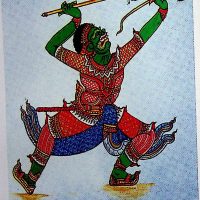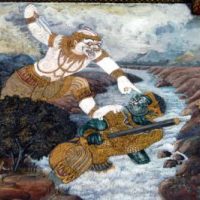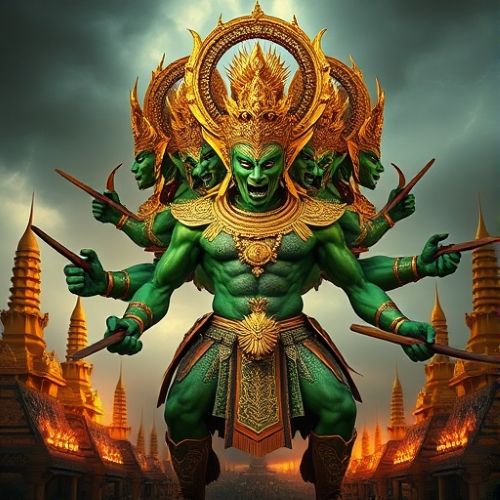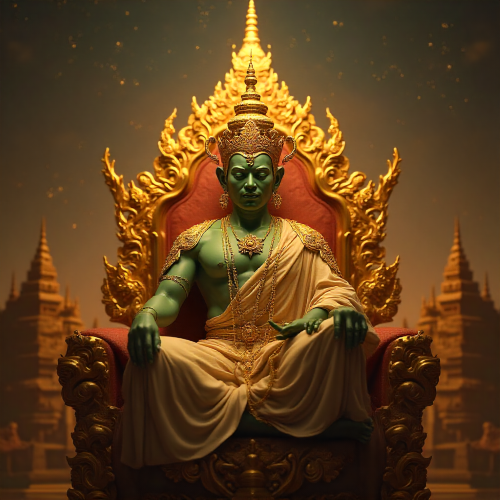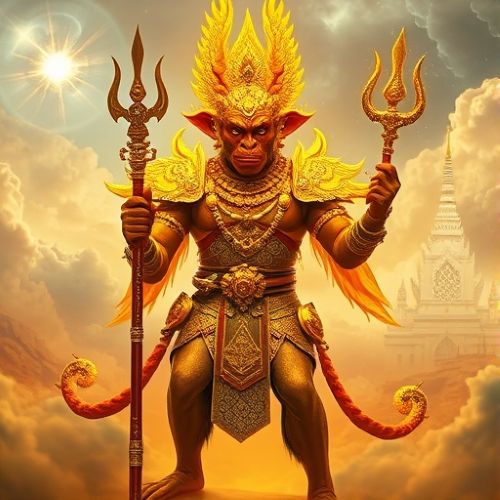Kumphakan: The Noble Giant of the Ramakien
Listen
At a glance
| Description | |
|---|---|
| Origin | Thai Mythology |
| Classification | Demigods |
| Family Members | Lastian, Rachada (Parents), Thotsakan (Brother), Canthavadi, Khanthamali (Wives) |
| Region | Thailand |
| Associated With | Loyalty, Royalty, Size, Strength |
Kumphakan
Introduction
Kumphakan (Thai: กุมภกรรณ), the mighty viceroy of Longka, stands as one of the most fascinating and tragic figures in Thai mythology. Featured prominently in the Ramakien—Thailand’s adaptation of the Ramayana—he is the younger brother of Thotsakan (Ravana), the demon king who wages war against Phra Ram (Rama). Unlike his brother’s arrogance, Kumphakan is characterized by honor, wisdom, and deep loyalty. Though he fights on the side of evil, his motives stem from love for his family rather than malice. His tale captures the essence of moral conflict, portraying a warrior torn between righteousness and duty, making him one of the most humanized figures among the asuras in Southeast Asian mythology.
Physical Traits
In Thai depictions, Kumphakan is shown as a colossal figure with a radiant green complexion, a symbol of his supernatural strength and noble spirit. He is often portrayed without a crown, signifying humility despite his high rank. His physical form is immensely powerful—broad shoulders, bulging arms, and a towering stature that inspires awe on the battlefield. In classical murals at Wat Phra Kaew in Bangkok, Kumphakan appears wielding divine weapons, standing steadfast against celestial forces. Khon (masked dance-drama) performances bring his image to life with intricately crafted green masks, emphasizing sharp tusks and expressive eyes that reflect both ferocity and sorrow. These physical traits encapsulate his dual nature: a fearsome warrior driven by an inner moral compass.
Family
Born to Lastian (Vishrava) and Rachada (Kaikesi), Kumphakan shares his lineage with the royal family of Longka. His elder brother, Thotsakan, serves as the principal antagonist of the Ramakien, while his younger brother Phiphek (Vibhishana) defects to aid Phra Ram, highlighting the moral divides within their family. Kumphakan’s familial bonds define much of his narrative—his loyalty to Thotsakan leads him to war despite his awareness of the king’s wrongdoing. In some retellings, he is married to Canthavadi and Khanthamali, both of whom lament his noble but doomed fate. His relationships reveal a deep sense of familial devotion, portraying him as a tragic hero trapped in the web of kinship and destiny.
Other names
Kumphakan’s name originates from the Sanskrit Kumbhakarna, meaning “pot-eared,” a reference to his distinctive physical features in Indian mythology. Across Asia, his name varies: in Javanese traditions, he is called Kumbhakarna; in Burmese texts, Kumbikhanna; and in Thai, Phra Kumphakan—the honorific “Phra” signifying respect for his valor and virtue. These variations highlight the widespread influence of the Ramayana across Southeast Asia and Thailand’s ability to localize universal mythic archetypes. The Thai interpretation of Kumphakan shifts focus from a monstrous demon to a compassionate warrior, underscoring the Ramakien’s cultural adaptation and moral nuance.
Powers and Abilities
Kumphakan’s legendary might and intellect distinguish him from other demons in the Ramakien. His physical strength is said to rival that of ten thousand men, and his roars could shake mountains. During his campaign against Phra Ram, Kumphakan used both brute force and strategic mastery.
He wielded the divine weapon Hok Mokkhasak (Moksasakti), a spear granted by Phra Phrom (Brahma), capable of unleashing destructive energy. In another account, he cleverly manipulated nature—diverting rivers and damming waters to trap enemy forces. Kumphakan’s resilience was unmatched; his body could endure celestial arrows, and his endurance in battle became legendary.
Despite these godlike abilities, his true power lay in his discipline and morality. He repeatedly cautioned Thotsakan against pride and deceit, urging peace over war. However, when duty demanded, he faced Phra Ram’s army with unmatched valor. His death, brought about by a divine arrow from Phra Ram, symbolizes the triumph of dharma over adharma but also evokes deep pathos for a warrior slain for loyalty rather than hatred.
Modern Day Influence
Kumphakan’s image continues to shape Thai art, culture, and philosophy. In Khon performances, he is a favorite character, often portrayed in scenes of grand battle and poignant farewell. His green mask and distinctive costume are iconic elements of Thailand’s classical dance tradition. At Wat Phra Kaew, temple murals immortalize his fight against the celestial armies, capturing his strength and sorrow with exquisite detail.
In contemporary times, Kumphakan has inspired literary reinterpretations, visual art, and modern media. Television adaptations and animated renditions often present him as a misunderstood anti-hero, emphasizing his wisdom and tragic nobility. Thai educators frequently reference his story in moral lessons, highlighting his unwavering sense of duty despite inner conflict.
Moreover, Kumphakan’s symbolism extends beyond mythology—he represents integrity amidst chaos, and the struggle between personal conscience and obligation. In this way, he continues to resonate deeply within Thai society, embodying a timeless lesson about the balance of strength, wisdom, and compassion.
Related Images
Source
Wisdomlib. (n.d.). Kumphakan (Kumbhakarna) [Ramakien Characters]. Retrieved from https://www.wisdomlib.org/gallery/ramakien-characters/8286
Wikipedia contributors. (2023). Ramakien. Wikipedia. Retrieved from https://en.wikipedia.org/wiki/Ramakien
MyThaiSpot. (2025, June 18). Who’s Who in Thai Literature: The Characters of Ramakien. Retrieved from https://www.mythaispot.com/posts/2025/06/18/whos-who-in-thai-literature-the-characters-of-ramakien/
Bunnag, T. (1990). Thai Ramayana: The Ramakien. Bangkok: Thai Cultural Center Press.
Chitakasem, M. (Ed.). (1995). Thai Literary Traditions. Bangkok: Silkworm Books.
Reynolds, F. E. (2006). Myth and Ritual in Thai Culture. Journal of Southeast Asian Studies, 37(2), 245–260.
Srisakra, V. (2001). Khon and the Ramakien: Thai Classical Dance Drama. Thai Performing Arts Journal, 12(1), 15–29.
Rajadhon, P. A. (1961). Essays on Thai Folklore. Bangkok: Siam Society.
ThaiHug. (2023). The Ramakien: Characters and Contexts. Retrieved from https://thaihug.com/ramakien-thai-epic/
Mystical Dynasty. (2015, January 28). Thai God/Mythological Characters. Retrieved from https://mysticaldynasty.wordpress.com/2015/01/28/thai-god-mythological-characters/
Grafiati. (2022, February 2). Books: ‘Thai Mythology.’ Retrieved from https://www.grafiati.com/en/literature-selections/thai-mythology/
Frequently Asked Questions
Who is Kumphakan in Thai mythology?
Kumphakan is the younger brother of Thotsakan (Ravana) in the Thai Ramakien. He is portrayed as a powerful yet noble demon warrior who fights out of loyalty rather than malice.
How is Kumphakan different from Thotsakan?
While Thotsakan represents arrogance and greed, Kumphakan embodies humility, wisdom, and loyalty. He is often depicted as a tragic figure bound by familial duty.
What are Kumphakan’s main powers?
Kumphakan possesses immense physical strength, magical resistance, and mastery of divine weapons like the Hok Mokkhasak spear, gifted by Phra Phrom (Brahma).
How did Kumphakan die in the Ramakien?
Kumphakan was ultimately slain by Phra Ram (Rama) with a divine arrow during battle, marking one of the epic’s most emotional and symbolic moments.
How is Kumphakan remembered in modern Thailand?
Kumphakan remains a key figure in Thai performing arts, temple murals, and moral teachings. His story symbolizes the struggle between duty and righteousness and continues to inspire art and storytelling across Thailand.



